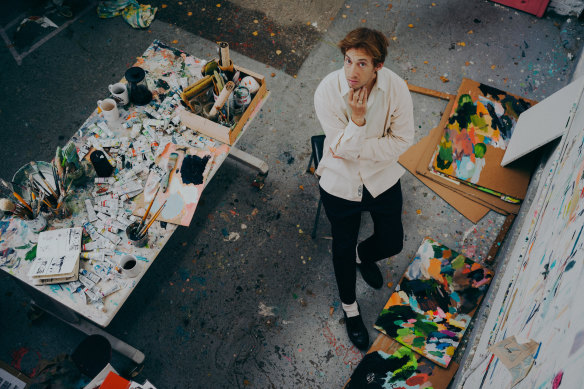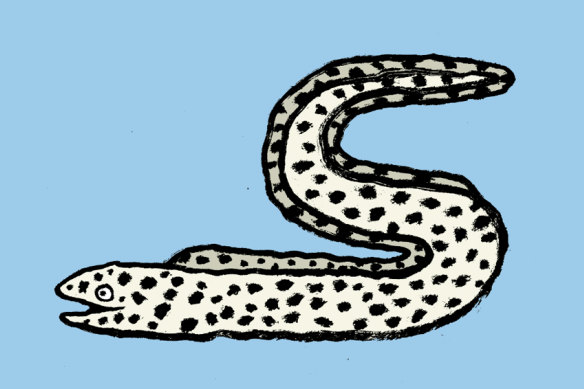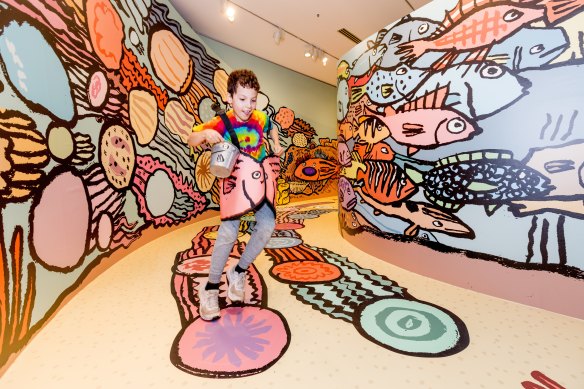Jean Jullien only took up surfing in his 30s, but he has always felt connected to the sea and those who make a living from it. “My family has always had this attachment to a place in Brittany called Lesconil, where I’ve got a studio,” he says. “My dad fishes a lot and I draw what he fishes. My great-grandfather was a fishmonger and my grandmother worked with him.”
Long before he first jumped on a board, his aunt and uncle ran a surf shop; he remembers it as a haven of neon colours and people who talked about shredding. “So yes, there was a lot of heritage of marine inspiration.”
In his own working life, Jullien straddles fine art, illustration and commercials, a torrent of activity and enthusiasm that swirls through his installation at the National Gallery of Victoria, an imaginary underwater world called Rififi. Children – and adults, for that matter – are invited to immerse themselves among the strange alien creatures, colourful coral reefs and “swimming” cut-out fish, while helping pick up fictitious rubbish.
At its heart is a recognition of the sea as a natural but vulnerable ecological system, but Rififi also includes an octopus teaching art and a starfish teaching yoga.
Jullien admits he was in two minds about going down the anthropomorphic route.
“But what we’re doing is trying to get kids excited and involved. We all grew up reading books where the fish talked, so if you like talking fishes then you will follow that with more scientifically accurate fishes. That’s good. I think it’s all the same. A stick man and a da Vinci drawing are the same character, just drawn differently.”
Jullien has been drawing almost continuously since he could make a mark; even as a child, he filled journals with his sketched observations of the quirky everyday. Every class has the kid who draws: that was him.
“But there were a lot of us,” he says. “I was just the kid who carried on.” From the start, his style was simplified, direct and immediate: superficially similar to computer graphics, although he prefers not only to use his hands, but to draw with a brush, because the hairs can go anywhere, introducing an element of chance to the image.
Jean Jullien in his Paris studio.Credit: Antoine Doyen / Mirage Collectif
When I go to meet him in Paris, he is busy in the basement of a pop-up shop selling some of the clothes he designs – he says he is fascinated by clothes – and painting a surfboard with some of his trademark graphic images. Is this a working board?
“Oh yes, it works,” he says. “But it’s a bit expensive. You probably wouldn’t want to take it out.”
Credit: Jean Jullien
He took up surfing just seven years ago, when his first son was born; he was working for a spread of commercial clients and thought he should learn to decelerate. “I just felt exhausted and I wanted to slow down, to be mentally and physically available for my family,” he says. “I think it is in me to produce a lot but, at that time, I found a certain solace in it, the contemplative aspect of it.”
The one-man conglomerate that is Jean Jullien first gained traction when he was studying at St Martin’s School of Art in London, which coincided with the rise of social media. His attitude to modern connectivity is deeply ambivalent: he has made several immediately meme-worthy images of people ignoring each other as they scroll through their phones over dinner.
‘A stick man and a da Vinci drawing are the same character, just drawn differently.’
Jean Jullien
He’s a chief offender, he admits, but “anyone would agree it’s terrible, it’s a terrible thing”. At 40, he says he feels too old for Instagram. “I do it because I have to.” TikTok? “Oh gosh, no!”
Loading
At the same time, his success is a phenomenon of social media. “That’s how I started, at St Martin’s and then the Royal College of Art, sharing work online because it was the birth of the blog culture, Myspace and all that. My work got seen by this guy and that guy and more and more I got contacted to do visuals for exhibitions, concerts and whatnot, and then I was doing T-shirt collections using my drawings, always with friends in St Martins screen-printing them in their workshop and then taking photos, doing, like, homemade catalogues.
“And just by doing lots of different stuff and sharing it, that sort of grabbed some people’s attention and then I never stopped doing it. Even though I now find social media difficult – it stresses me out, so I do less of it – I keep doing stuff, and fortunately some people like it and then repost it, so it carries on.”
His CV includes graphics for advertising campaigns for companies ranging from RCA Records to shoe companies and luxury hotels. Now he only does advertising work for charities.
“Like everyone, I read the news about the environment and mass-produced items, and I think I have a fairly normal moral response. It bothers me a lot.”
He grew up in what he considers the golden age of advertising art, crazy inventions in which the selling of a product seemed distinctly secondary.
“To me, they were making paintings in the streets. Now we are in a different era. I think collectively we are savvier about what the capitalistic market is, how things are made, how detrimental they might be – and you don’t necessarily want to be the guy who helped someone bad sell something bad to people.
A young visitor to RIFIFI: Jean Jullien for Kids at NGV Triennial. Credit: Tim Carrafa
“But, you know, I would not be pointing fingers at anyone, because I did advertising for companies I wouldn’t necessarily work with now. It’s a privilege to be able to pick your clients, I think. And I still do things I wouldn’t want to do – taking a plane for example. I haven’t done it for a holiday for years but I still do it for work. You just have to try your best.
“The project with the NGV is amazing. It’s more fine art, but it’s public-facing and this is exactly the kind of project I want to be working towards.”
So does he see himself as a fine artist? He laughs and shrugs.
“If I say I’m a fine artist I sound pompous,” he says. “If I say I am an illustrator, I’m looked down on by fine artists. So I don’t say I’m either. I just make stuff.”
Rififi is showing at NGV International as part of the Triennial exhibition, until April 7, 2024.
The Booklist is a weekly newsletter for book lovers from books editor Jason Steger. Get it delivered every Friday.
>>> Read full article>>>
Copyright for syndicated content belongs to the linked Source : Brisbane Times – https://www.brisbanetimes.com.au/culture/art-and-design/can-this-french-artist-s-talking-fish-help-your-kids-save-the-planet-20231208-p5eq3z.html?ref=rss&utm_medium=rss&utm_source=rss_feed

































